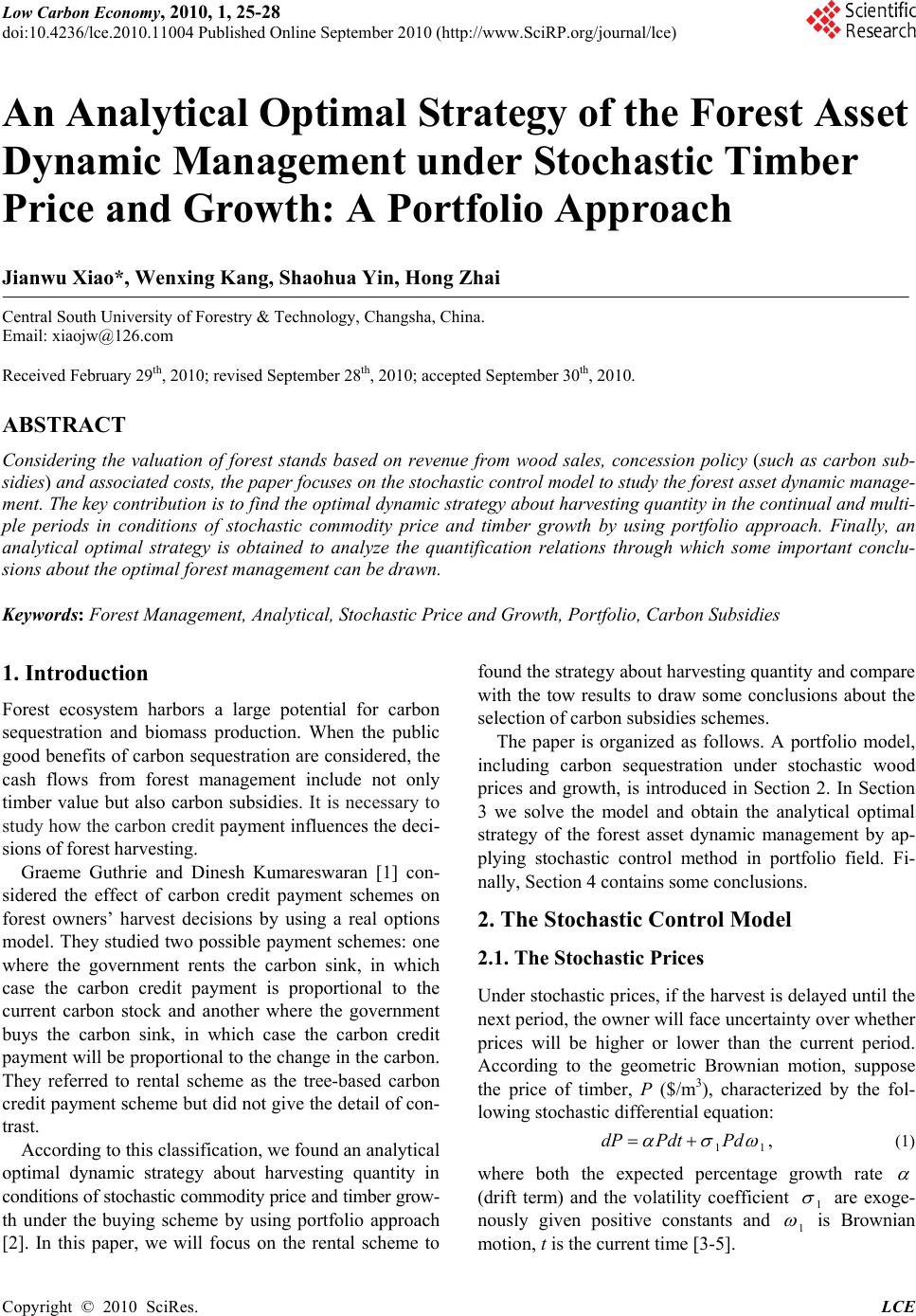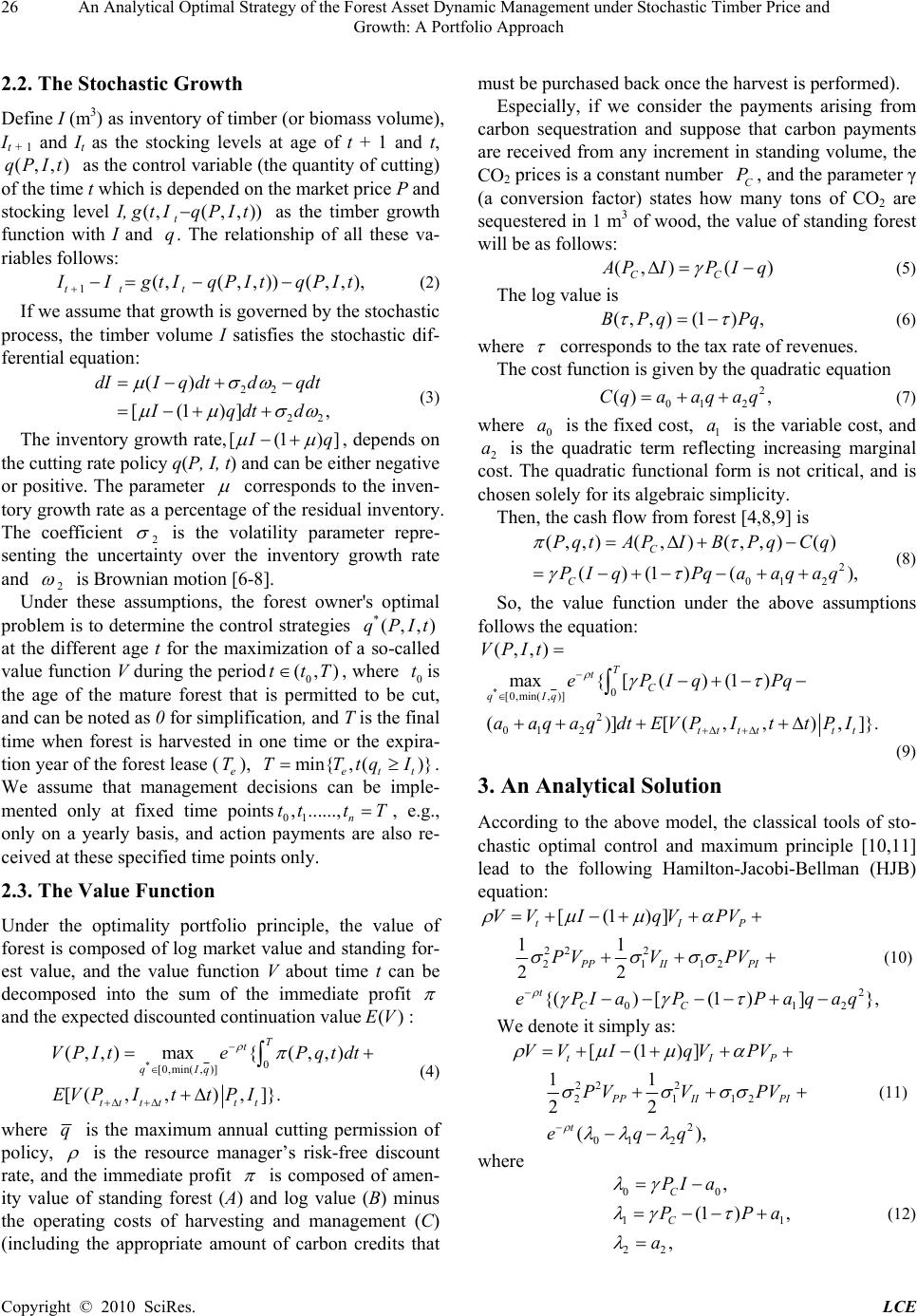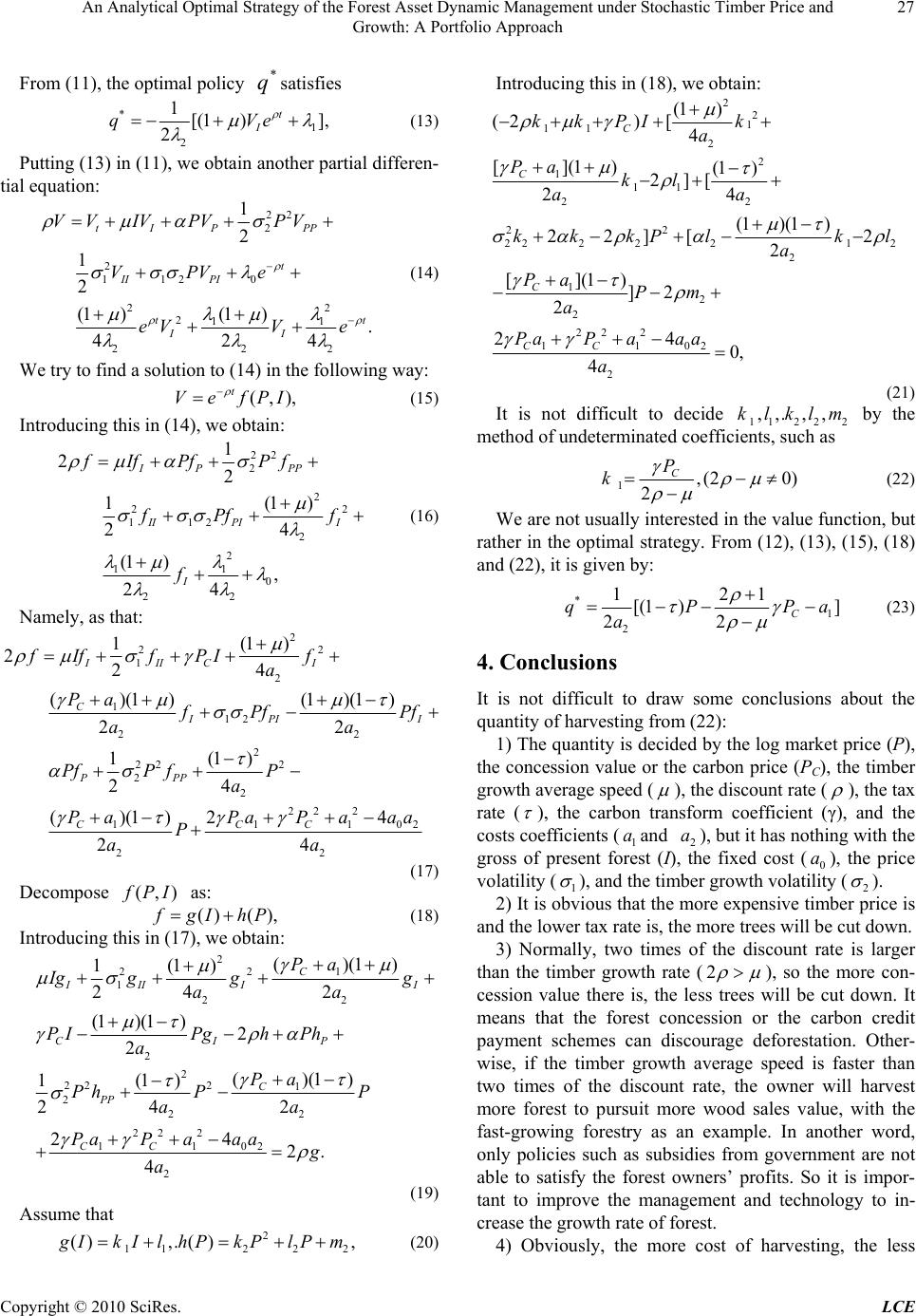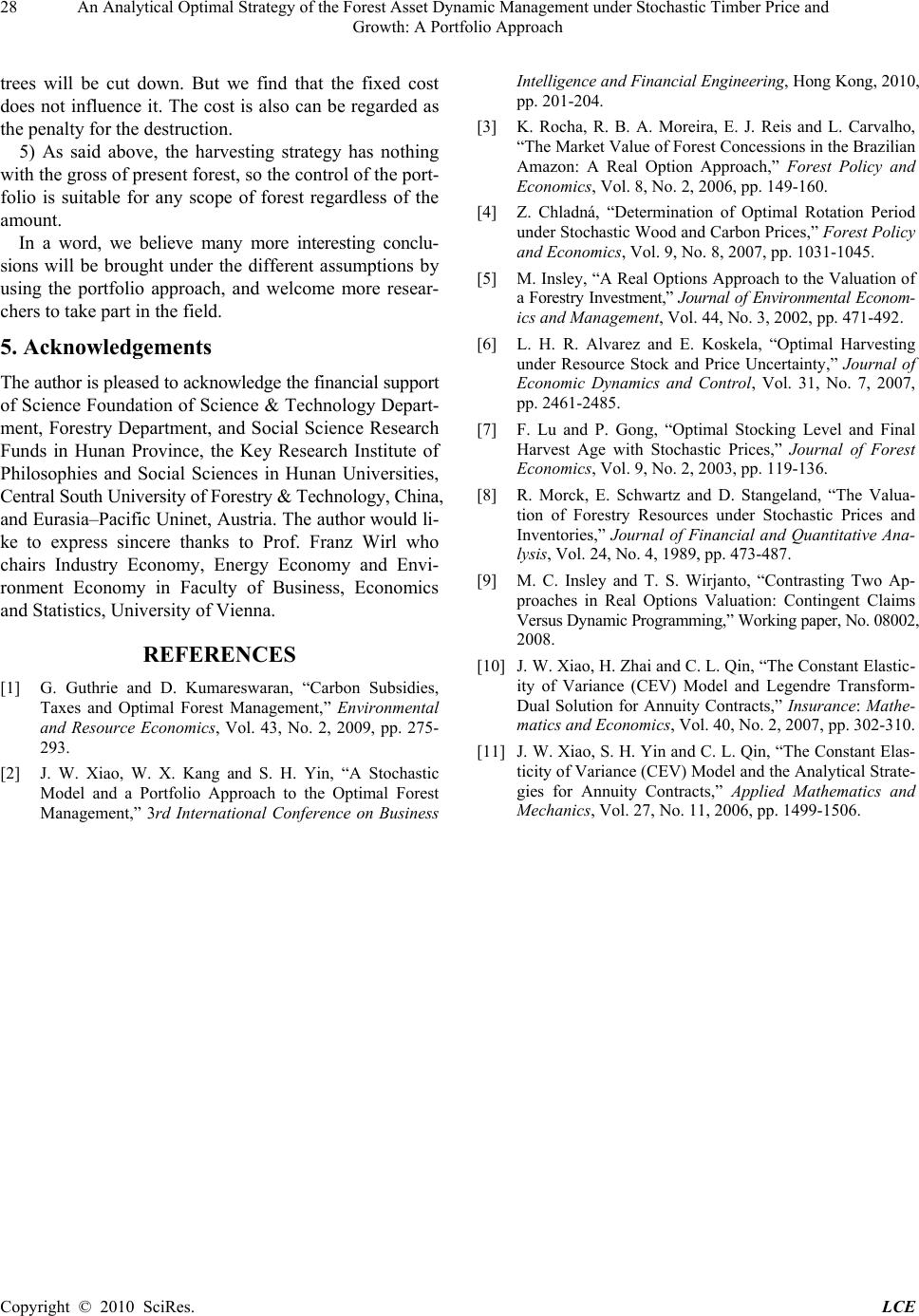Paper Menu >>
Journal Menu >>
 Low Carbon Economy, 2010, 1, 25-28 doi:10.4236/lce.2010.11004 Published Online September 2010 (http://www.SciRP.org/journal/lce) Copyright © 2010 SciRes. LCE 1 An Analytical Optimal Strategy of the Forest Asset Dynamic Management under Stochastic Timber Price and Growth: A Portfolio Approach Jianwu Xiao*, Wenxing Kang, Shaohua Yin, Hong Zhai Central South University of Forestry & Technology, Changsha, China. Email: xiaojw@126.com Received February 29th, 2010; revised September 28th, 2010; accepted September 30th, 2010. ABSTRACT Considering the valuation of forest stands based on revenue from wood sales, concession policy (such as carbon sub- sidies) and associated costs, the paper focuses on the stochastic control model to study the forest asset dynamic manage- ment. The key contribution is to find the optimal dynamic strategy about harvesting quantity in the continual and multi- ple periods in conditions of stochastic commodity price and timber growth by using portfolio approach. Finally, an analytical optimal strategy is obtained to analyze the quantification relations through which some important conclu- sions about the optimal forest management can be drawn. Keywords: Forest Management, Analytical, Stochastic Price and Growth, Portfolio, Carbon Subsidies 1. Introduction Forest ecosystem harbors a large potential for carbon sequestration and biomass production. When the public good benefits of carbon sequestration are considered, the cash flows from forest management include not only timber value but also carbon subsidies. It is necessary to study how the carbon credit payment influences the deci- sions of forest harvesting. Graeme Guthrie and Dinesh Kumareswaran [1] con- sidered the effect of carbon credit payment schemes on forest owners’ harvest decisions by using a real options model. They studied two possible payment schemes: one where the government rents the carbon sink, in which case the carbon credit payment is proportional to the current carbon stock and another where the government buys the carbon sink, in which case the carbon credit payment will be proportional to the change in the carbon. They referred to rental scheme as the tree-based carbon credit payment scheme but did not give the detail of con- trast. According to this classification, we found an analytical optimal dynamic strategy about harvesting quantity in conditions of stochastic commodity price and timber grow- th under the buying scheme by using portfolio approach [2]. In this paper, we will focus on the rental scheme to found the strategy about harvesting quantity and compare with the tow results to draw some conclusions about the selection of carbon subsidies schemes. The paper is organized as follows. A portfolio model, including carbon sequestration under stochastic wood prices and growth, is introduced in Section 2. In Section 3 we solve the model and obtain the analytical optimal strategy of the forest asset dynamic management by ap- plying stochastic control method in portfolio field. Fi- nally, Section 4 contains some conclusions. 2. The Stochastic Control Model 2.1. The Stochastic Prices Under stochastic prices, if the harvest is delayed until the next period, the owner will face uncertainty over whether prices will be higher or lower than the current period. According to the geometric Brownian motion, suppose the price of timber, P ($/m3), characterized by the fol- lowing stochastic differential equation: 1,dPPdtPd 1 (1) where both the expected percentage growth rate (drift term) and the volatility coefficient 1 are exoge- nously given positive constants and 1 is Brownian motion, t is the current time [3-5].  26 An Analytical Optimal Strategy of the Forest Asset Dynamic Management under Stochastic Timber Price and Growth: A Portfolio Approach 2.2. The Stochastic Growth Define I (m3) as inventory of timber (or biomass volume), It + 1 and It as the stocking levels at age of t + 1 and t, as the control variable (the quantity of cutting) of the time t which is depended on the market price P and stocking level I, (,,)qPIt (,(,, )) t g tI qPIt q as the timber growth function with I and . The relationship of all these va- riables follows: 1(,(, ,))(, ,), tt t I IgtIqPItqPIt (2) If we assume that growth is governed by the stochastic process, the timber volume I satisfies the stochastic dif- ferential equation: 22 22 () [(1)] dIIq dtdqdt Iqdtd , ] (3) The inventory growth rate,[(1) I q , depends on the cutting rate policy q(P, I, t) and can be either negative or positive. The parameter corresponds to the inven- tory growth rate as a percentage of the residual inventory. The coefficient 2 is the volatility parameter repre- senting the uncertainty over the inventory growth rate and 2 is Brown motion [6-8]. nia Under these assumptions, the forest owner's optimal problem is to determine the control strategies at the different age t for the maximization of a so-called value function V during the period0, where 0is the age of the mature forest that is permitted to be cut, and can be noted as 0 for simplification, and T is the final time when forest is harvested in one time or the expira- tion year of the forest lease (e T), We assume that management decisions can be imple- mented only at fixed time points01 n *(,,)qPIt t ( )} ett tqI. T (,)tt T min{TT , ......,tt , t , e.g., only on a yearly basis, and action payments are also re- ceived at these specified time points only. 2.3. The Value Function Under the optimality portfolio principle, the value of forest is composed of log market value and standing for- est value, and the value function V about time t can be decomposed into the sum of the immediate profit and the expected discounted continuation value: ()EV *0 [0,min( ,)] (,,)max{(,,) [(,,), ]}. T t qIq tt ttt t VPIte Pqtdt EV PIttP I (4) where q is the maximum annual cutting permission of policy, is the resource manager’s risk-free discount rate, and the immediate profit is composed of amen- ity value of standing forest (A) and log value (B) minus the operating costs of harvesting and management (C) (including the appropriate amount of carbon credits that must be purchased back once the harvest is performed). Especially, if we consider the payments arising from carbon sequestration and suppose that carbon payments are received from any increment in standing volume, the CO2 prices is a constant number C, and the parameter γ (a conversion factor) states how many tons of CO2 are sequestered in 1 m3 of wood, the value of standing forest will be as follows: P (, )() CC A PI PIq (5) The log value is (,, )(1),BPqPq (6) where corresponds to the tax rate of revenues. The cost function is given by the quadratic equation 2 01 2 () ,Cqaaq aq (7) where 0 is the fixed cost, 1 is the variable cost, and 2 is the quadratic term reflecting increasing marginal cost. The quadratic functional form is not critical, and is chosen solely for its algebraic simplicity. a a a Then, the cash flow from forest [4,8,9] is 2 01 2 (,,)( ,)(,,)() ()(1) ( C C PqtAPIB Pq Cq PIqPqaaq aq ), (8) So, the value function under the above assumptions follows the equation: (,,)VPIt *0 [0,min( , )] 2 01 2 max{[() (1) ()][(,,) T t C qIq tt ttt t ePIqPq aaqaqdtEVP It tPI ,]}. (9) 3. An Analytical Solution According to the above model, the classical tools of sto- chastic optimal control and maximum principle [10,11] lead to the following Hamilton-Jacobi-Bellman (HJB) equation: 22 2 2112 2 01 [(1)] 11 22 {() [(1)]}, tIP PP IIPI t CC VVIqVPV PVV PV ePIaP Paqaq 2 (10) We denote it simply as: 22 2 2112 2 01 2 [(1)] 11 22 (), tI PP IIPI t VVIqVPV PVV PV eqq P a (11) where 00 11 22 , (1 ), , C C PIa PP a (12) Copyright © 2010 SciRes. LCE  An Analytical Optimal Strategy of the Forest Asset Dynamic Management under Stochastic Timber Price and 27 Growth: A Portfolio Approach From (11), the optimal policy satisfies * q * 1 2 1[(1 )], 2 t I qVe (13) Putting (13) in (11), we obtain another partial differen- tial equation: 22 2 2 112 0 2 2 211 22 1 2 1 2 (1 ) (1 ). 424 tI PPP t II PI tt II VV IVPVPV VPVe eVV e 2 (14) We try to find a solution to (14) in the following way: (,), t VefPI (15) Introducing this in (14), we obtain: 22 2 2 2 112 2 2 11 0 22 1 22 1(1 24 (1 ), 24 IP PP II PII I fIfPf Pf fPf f f 2 ) (16) Namely, as that: 2 22 1 2 1 12 2 2 22 2 2 2 22 2 111 22 1(1) 224 ()(1) (1)(1 ) 2 1(1) 24 ()(1)2 4 24 IIIC I C IPI PPP CCC fIffPIf a Pa 2 02 2 I f Pf Pf a PfPfP a PaPaP aaa P aa a (17) Decompose (,) f PI as: ()(), f gI hP (18) Introducing this in (17), we obtain: 2 22 1 1 22 2 2 222 1 2 22 222 1102 2 ()(1) 1(1) 24 2 (1)(1 )2 2 ()(1) 1(1) 24 2 24 2. 4 C III I CIP C PP CC Pa I I gg gg aa PIPgh Ph a Pa Ph PP aa PaP aaag a (19) Assume that 2 112 22 (),.( ), g IkIlhPkPlPm (20) Introducing this in (18), we obtain: 2 2 1 11 2 2 1 11 22 22 222221 2 2 1 2 2 22 2 1102 2 (1 ) (2)[ 4 [](1) (1 ) 2][ 24 (1)(1 ) 22][2 2 [](1) ]2 2 24 0, 4 C C C CC kkPI k a Pa kl aa kkkPlk a Pa Pm a PaP aaa a l (21) It is not difficult to decide 11 22 by the method of undeterminated coefficients, such as 2 ,,. ,,klklm 1,(2 0) 2 C P k (22) We are not usually interested in the value function, but rather in the optimal strategy. From (12), (13), (15), (18) and (22), it is given by: * 1 2 121 [(1 )] 22 C qPP a a (23) 4. Conclusions It is not difficult to draw some conclusions about the quantity of harvesting from (22): 1) The quantity is decided by the log market price (P), the concession value or the carbon price (PC), the timber growth average speed ( ), the discount rate ( ), the tax rate ( ), the carbon transform coefficient (γ), and the costs coefficients (1and 2), but it has nothing with the gross of present forest (I), the fixed cost (0), the price volatility ( a a a 1 ), and the timber growth volatility (2 ). 2) It is obvious that the more expensive timber price is and the lower tax rate is, the more trees will be cut down. 3) Normally, two times of the discount rate is larger than the timber growth rate (2 ), so the more con- cession value there is, the less trees will be cut down. It means that the forest concession or the carbon credit payment schemes can discourage deforestation. Other- wise, if the timber growth average speed is faster than two times of the discount rate, the owner will harvest more forest to pursuit more wood sales value, with the fast-growing forestry as an example. In another word, only policies such as subsidies from government are not able to satisfy the forest owners’ profits. So it is impor- tant to improve the management and technology to in- crease the growth rate of forest. 4) Obviously, the more cost of harvesting, the less Copyright © 2010 SciRes. LCE  28 An Analytical Optimal Strategy of the Forest Asset Dynamic Management under Stochastic Timber Price and Growth: A Portfolio Approach Copyright © 2010 SciRes. LCE trees will be cut down. But we find that the fixed cost does not influence it. The cost is also can be regarded as the penalty for the destruction. 5) As said above, the harvesting strategy has nothing with the gross of present forest, so the control of the port- folio is suitable for any scope of forest regardless of the amount. In a word, we believe many more interesting conclu- sions will be brought under the different assumptions by using the portfolio approach, and welcome more resear- chers to take part in the field. 5. Acknowledgements The author is pleased to acknowledge the financial support of Science Foundation of Science & Technology Depart- ment, Forestry Department, and Social Science Research Funds in Hunan Province, the Key Research Institute of Philosophies and Social Sciences in Hunan Universities, Central South University of Forestry & Technology, China, and Eurasia–Pacific Uninet, Austria. The author would li- ke to express sincere thanks to Prof. Franz Wirl who chairs Industry Economy, Energy Economy and Envi- ronment Economy in Faculty of Business, Economics and Statistics, University of Vienna. REFERENCES [1] G. Guthrie and D. Kumareswaran, “Carbon Subsidies, Taxes and Optimal Forest Management,” Environmental and Resource Economics, Vol. 43, No. 2, 2009, pp. 275- 293. [2] J. W. Xiao, W. X. Kang and S. H. Yin, “A Stochastic Model and a Portfolio Approach to the Optimal Forest Management,” 3rd International Conference on Business Intelligence and Financial Engineering, Hong Kong, 2010, pp. 201-204. [3] K. Rocha, R. B. A. Moreira, E. J. Reis and L. Carvalho, “The Market Value of Forest Concessions in the Brazilian Amazon: A Real Option Approach,” Forest Policy and Economics, Vol. 8, No. 2, 2006, pp. 149-160. [4] Z. Chladná, “Determination of Optimal Rotation Period under Stochastic Wood and Carbon Prices,” Forest Policy and Economics, Vol. 9, No. 8, 2007, pp. 1031-1045. [5] M. Insley, “A Real Options Approach to the Valuation of a Forestry Investment,” Journal of Environmental Econom- ics and Management, Vol. 44, No. 3, 2002, pp. 471-492. [6] L. H. R. Alvarez and E. Koskela, “Optimal Harvesting under Resource Stock and Price Uncertainty,” Journal of Economic Dynamics and Control, Vol. 31, No. 7, 2007, pp. 2461-2485. [7] F. Lu and P. Gong, “Optimal Stocking Level and Final Harvest Age with Stochastic Prices,” Journal of Forest Economics, Vol. 9, No. 2, 2003, pp. 119-136. [8] R. Morck, E. Schwartz and D. Stangeland, “The Valua- tion of Forestry Resources under Stochastic Prices and Inventories,” Journal of Financial and Quantitative Ana- lysis, Vol. 24, No. 4, 1989, pp. 473-487. [9] M. C. Insley and T. S. Wirjanto, “Contrasting Two Ap- proaches in Real Options Valuation: Contingent Claims Versus Dynamic Programming,” Working paper, No. 08002, 2008. [10] J. W. Xiao, H. Zhai and C. L. Qin, “The Constant Elastic- ity of Variance (CEV) Model and Legendre Transform- Dual Solution for Annuity Contracts,” Insurance: Mathe- matics and Economics, Vol. 40, No. 2, 2007, pp. 302-310. [11] J. W. Xiao, S. H. Yin and C. L. Qin, “The Constant Elas- ticity of Variance (CEV) Model and the Analytical Strate- gies for Annuity Contracts,” Applied Mathematics and Mechanics, Vol. 27, No. 11, 2006, pp. 1499-1506. |

